
On 24 March 2022, the Democratic People's Republic of Korea (DPRK) conducted an apparent full-range test of an intercontinental ballistic missile (ICBM). This was the first such test since November 2017 and marked the end of the DPRK's ICBM and nuclear test moratorium. [1]
This brief offers some initial observations on the ICBM test, based on available information.
Trajectory
The Joint Chiefs of Staff (JCS) of the Republic of Korea (ROK) and the Japanese Ministry of Defense (MoD) reported on 24 March 2022 that the ICBM was launched at around 2:33 pm local time. [2] It followed a highly lofted trajectory, reaching an apogee of over 6200 km before splashing down about 150 km west of Japan's Oshima Peninsula, 1080 km away from the DPRK's launch site at Sunan airfield (Figure 1). [3] The entire flight took about 71 minutes. [4]
The figures released by the DPRK on 25 March are in general accordance with the figures from Japan and the ROK. KCNA stated that the missile "traveled up to a maximum altitude of 6248.5 km and flew a distance of 1090 km for 4052s [67.5 minutes] before accurately hitting the pre-set area in open waters of the East Sea of Korea." [5]
Commercial satellite images available to ONN did not show the situation on the ground at the time of the launch.
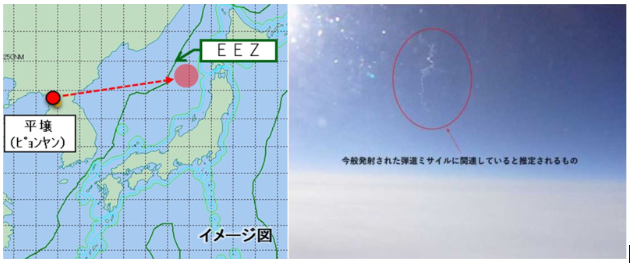
Figure 1. Left: map released by the Japanese MoD, showing that the test missile fell within Japan’s exclusive economic zone (EEZ). Right: a trail presumably left by the ICBM flight test. Images: Japanese MoD
The test launch of the ICBM follows several strong indicators that the DPRK would soon conduct an ICBM test or a satellite launch. These indicators, which ONN analyzed further in a brief dated 14 March 2022 [6], include:
-
27 February 2022, the DPRK conducted a test for developing a reconnaissance satellite. [7]
-
5 March 2022, another similar test was carried out. [8]
-
9 March 2022, US Indo-Pacific Command announced that it had ordered "intensified Intelligence, Surveillance, and Reconnaissance collection activities in the Yellow Sea." [9]
-
9 March 2022, DPRK leader Kim Jong Un inspected the National Aerospace Development Administration (NADA). [10]
-
10 March 2022, US Department of Defense (DoD) announced that the tests conducted by the DPRK on 27 February and 5 March 2022 involved a new ICBM and that the purpose of the tests had likely been to evaluate this new ICBM before a future full-range test, potentially to be disguised as a satellite launch. [11]
-
10 March 2022, Kim Jong Un inspected the Sohae Satellite Launching Ground. [12]
-
16 March 2022, the DPRK launched what appeared to be a ballistic missile, possibly involving new ICBM technologies, from the Sunan area. The projectile appeared to have exploded at an altitude below 20 km. [13]
As can be seen in Table 1, the apogee of the launch on 24 March 2022 is significantly higher than apogees reached in previous tests, indicating that the newly-launched ICBM would have a higher maximum range, possibly reaching the 15000 km benchmark set forth during the 8th Party Congress of the Workers' Party of Korea in 2021. [14] That is also the assessment from Japan's Defense Minister Nobuo Kishi, who stated that the newly-launched ICBM was "capable of traveling over 15000 km." [15]
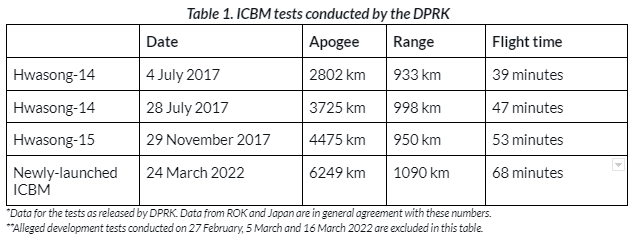
Following the ICBM test, the ROK military conducted a joint live-fire exercise involving precision guided munitions in a show of force. According to the ROK's JCS, one Hyunmoo-2 short range ballistic missile, one Army Tactical Missile System (ATACMS) ballistic missile, one Haesung-II ship-to-ground cruise missile and two JDAM guided bombs were used in the exercise. [16] The ROK responded to the 2017 DPRK ICBM tests in a similar fashion.
Missile
DPRK state media reported that the missile launched on 24 March was a Hwasong-17. [17] The Hwasong-17 made its public debut during a military parade in October 2020. According to ONN's measurement, the missile is slightly over 26 m long and its diameter is around 2.6 m (Figure 2). [18] This measurement is in alignment with the September 2021 report of the United Nations Panel of Experts which, citing a Member State, stated that the missile had a length of 25.8 m and a diameter of 2.6 m. [19]
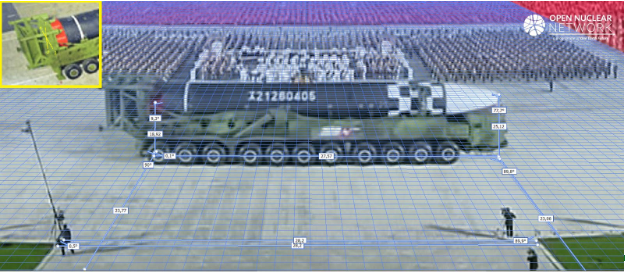
Figure 2. The missile's length and diameter can be estimated based on ground references that are also measurable in satellite imagery. Inset image: a red protective cover seems to show the contour of four engine nozzles. Images: KCTV and KCNA, annotated by ONN
The approximate size of the first stage suggests that the ICBM is powered by two dual-chamber engines that in total provide a thrust of ~180 ton of force in vacuum. [20] This new missile has double the thrust of the Hwasong-15 ICBM, enabling it to have a throw-weight of roughly 1.5 tons. [21] As can be seen in Figure 3, the Hwasong-17 does not reflect a significant technological breakthrough, but rather an effort to achieve the biggest possible payload while maintaining a certain degree of mobility.
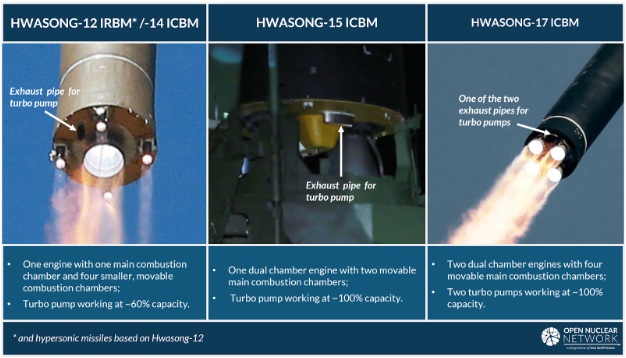
Figure 3. Common engine technologies shared by the new generation of liquid-propellant ballistic missiles of the DPRK. Images: KCNA, annotated by ONN
In comparison to heavy-weight liquid-propellant ICBMs, the Hwasong-17 is not a big missile. Other nuclear-armed states have had larger liquid-propellant ballistic missiles that could be launched from a firing table in an outdoor environment. [22] However, the Hwasong-17 is the largest liquid-propellant ballistic missile to date launched from a transporter-erector-launcher (TEL).
The lack of propellant vehicles in the photos and video footage released by the DPRK indicates that the Hwasong-17 was possibly fueled horizontally inside a support facility and was then transported to the launch location before the erection and launch process (Figure 4).
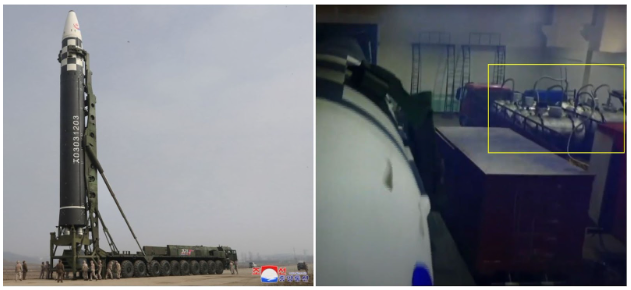
Figure 4. Left: no other support vehicles were visible in the image of the launch site. Right: trucks carrying propellant tanks (in yellow box) parked together with the Hwasong-17 inside the missile support facility. Images: KCNA, KCTV
A fully-fueled Hwasong-17 weighs over 100 tons. [23] Adding the mass of the TEL, the whole weapon system could weigh around 250 tons. [24] With this significant total mass, it is yet to be seen if a fully fuelled Hwasong-17 weapon system has any off-road capabilities and how long and how fast such a system could safely travel even on hardened roads. Judging by the photos and video footage released by the DPRK, the Hwasong-17 only traveled about 1100 meters from its suspected fuelling location, the Sil-li missile support facility, to the launch site (Figure 5). Thus, the operational radius for a TEL carrying a fully fuelled Hwasong-17 from its fueling/preparational site could be quite small, limiting its operational flexibility and survivability.
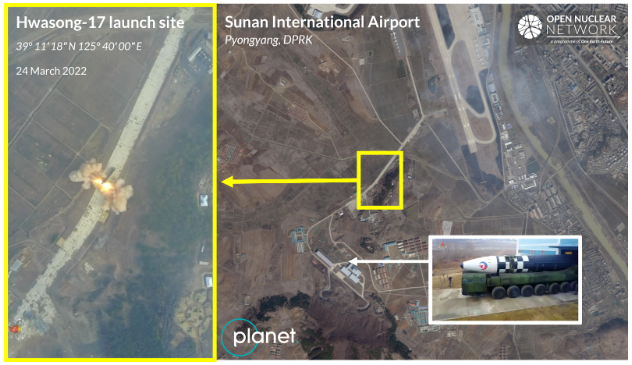
Figure 5. The Hwasong-17 ICBM was reportedly launched from a road connecting the Sil-li missile support facility and the Sunan International Airport, Pyongyang. Images: © 2022 Planet Labs Inc. All Rights Reserved, KCTV
In previous ICBM tests by the DPRK, the firing tables were detached from the TELs before launch, because if the missiles were to explode upon ignition, the TEL would be significantly damaged or destroyed. The Hwasong-17 is the first DPRK ICBM to be launched directly from a TEL (Figure 6). This indicates a high degree of confidence in the missile's reliability and safety.
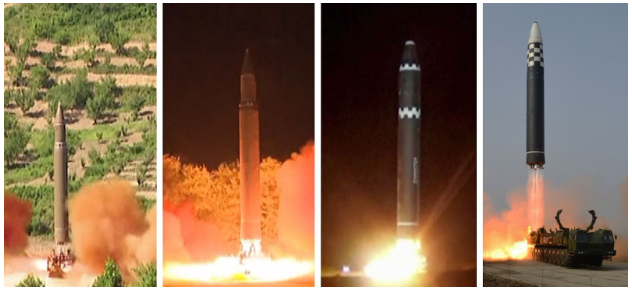
Figure 6. From left to right: ICBM launches of Hwasong-14, Hwasong-15 and Hwasong-17. Images: KCTV, KCNA
There are two payload possibilities for this ICBM: multiple nuclear warheads or a single, high-yield warhead.
The new ICBM could probably carry two Hwasong-15 warheads, giving it a multiple reentry vehicle (MRV) payload. The introduction of a dispenser (called a "bus") to independently direct each warhead - which would make it a multiple independent reentry vehicle (MIRV) - would eat into the payload capacity and add more complexity to the guidance system.
By contrast, a large single warhead has the benefit of using less fissile material than the combined material used in MRVs or MIRVs, while offering a relatively higher total yield. Given the size of the missile, a single warhead may be capable of delivering a warhead with a megaton level yield. A single warhead option may be more desirable for the DPRK, as it has a limited number of nuclear warheads and a weak air defence network.
Japan and the ROK have not released their assessments regarding the number of payloads. However, judging by the fact that KCNA described the flight without mentioning the warhead(s), [25] the Hwasong-17 likely did not carry multiple payloads during the 24 March 2022 test. Ultimately, the choice of payloads would depend on warhead production capabilities, the miniaturization progress and the will of the DPRK leadership.
Caveat
Certain discrepancies in the video released by KCTV have been discovered by Colin Zwirko, senior analytic correspondent for NK News. Mr. Zwirko suggests that the video footage of the Hwasong-17 aired by DPRK state media may have actually been shot on 16 March. [26] The projectile launched on that date appeared to have failed according to Japanese and ROK military reports. [27] The DPRK did not make any announcement in connection with that launch. Mr. Zwirko's theory seems to support reported discussions among the ROK military intelligence community that what was launched on 24 March 2022 could have been a Hwasong-15 with a significantly reduced payload. [28]
Assuming that the DPRK really passed off a Hwasong-15 flight on 24 March 2022 as a Hwasong-17 flight test, the DPRK leadership might be trying to give a false impression of the advancement of the DPRK's ICBM technologies. It would also mean, however, that the DPRK would likely try to attempt another launch of the Hwasong-17 in the near future. Other possibilities, such as the DPRK's use of old footage for better propaganda effect, could not be ruled out.
Implications and Outlooks
-
The ICBM test launch took place during the power transition in the ROK, from a pro-engagement administration headed by current president Moon Jae-in to a conservative administration under president-elect Yoon Suk-yeol. [29] The launch also came amid the ongoing military operations of Russia in Ukraine. The timing of the launch could be interpreted as sending a political message to both the old and new administrations in the ROK, or as an attempt to escape the attention of the international community. However, the development of the new ICBM and production of large-yield nuclear warheads are among the core tasks given during the 8th Congress of the Workers' Party of Korea. [30] It is therefore more plausible that the test was carried out primarily in accordance with the DPRK's own weapons development schedule.
-
As with previous nuclear tests, satellite launches and ICBM tests, the 24 March 2022 test is likely to result in further sanctions against the DPRK. However, coordinated international responses to the DPRK's actions could become increasingly difficult in the worsening international context .
-
The DPRK did not issue a special TV bulletin to celebrate the launch soon after the test, as it did following most nuclear and ICBM tests. However, on 25 March, DPRK state TV aired a heavily-edited 16-minute video report. [31] It is possible that the editing process delayed the airing of the TV report.
-
The 24 March 2022 launch indicates that the DPRK military industry is actively fulfilling the "five major goals for developing the defence power" it was given during the 8th Party Congress of the DPRK. The other remaining core tasks likely include: (1) developing ground and sea-based solid-propellant ballistic missiles of intercontinental range; (2) possessing nuclear-powered submarines and an underwater-launched nuclear strategic weapon; and (3) the possible test of more nuclear weapons. [32] Meanwhile, a satellite launch could also occur in the near future.
-
All DPRK ICBM tests to date have been carried out with highly lofted trajectories. As the DPRK is planning to launch more satellites, it could attempt to test ICBMs in normal trajectories while using space-based sensors to perform remote telemetry missions. [33]
Attachment
KCNA report, Striking Demonstration of Great Military Muscle of Juche Korea: Successful Test-Launch of New-Type ICBM. Respected Comrade Kim Jong Un Guides Test Launch of ICBM Hwasongpho-17, 24 March 2022
Pyongyang, March 25 (KCNA) -- The test-launch of a new type inter-continental ballistic missile Hwasongpho-17 of the DPRK strategic forces was conducted on March 24, Juche 111 (2022) under the direct guidance of Kim Jong Un, general secretary of the Workers' Party of Korea, president of the State Affairs of the Democratic People's Republic of Korea (DPRK) and supreme commander of the armed forces of the DPRK.
The respected Comrade Kim Jong Un gave a written order to conduct the test-launch of the new type ICBM of the DPRK strategic forces on Wednesday. He visited the launch ground on Thursday and personally guided the overall process of the test-launch of the new type ICBM Hwasongpho-17.
With his deep insight into the ever-changing international political situation, the root cause of the daily-escalating military tension in and around the Korean peninsula and the long-term demand of our revolution that stems from the inevitability of the long-standing confrontation with the U.S. imperialists accompanied by the danger of a nuclear war, the General Secretary put forward the Juche-oriented defence development strategy and the policy of bolstering in a sustained way the nuclear war deterrence at the historic 8th Congress of the WPK. Organizing and directing the crucial endeavors for bolstering the national defence capabilities to implement the strategy and policy, he, with top priority given to the development of the new-type ICBM in particular, provided detailed guidance and directions almost every day and made sure that the Hwasongpho-17 type weapon system, a symbol of Juche power and fruition of self-reliance, was completed as a core strike means and a reliable nuclear war deterrence means of the DPRK strategic forces.
Fully armed with his original idea on self-reliant defence strategy, officials, scientists and technicians in the field of national defence scientific research and the heroic workers in the munitions field, under his direct guidance, vigorously waged a research and development campaign with creative wisdom and unyielding mentality, thereby producing the new-type ICBM in a short time.
Kim Jong Un learned in detail about the preparations for the test-launch of the weapon at first hand on the spot on Thursday afternoon and gave an order to advance to the launching position.
He went to the launching position and gave detailed guidance until the last process of the launch, giving strength and courage to the defence scientists and missile maintenance crew involved in the launch to bring about a momentous time when the epochal development of the defence capabilities of the country would be demonstrated all over the world.
It was ready for the test launch, and the moment of a historic event has come.
The launching ground counting down to the test-launch of the huge strategic weapon was seething with the ardent anticipation of all the defence scientists and munitions workers to inform the whole world of the production of another powerful nuclear attack means by Juche Korea and to demonstrate with pride the reliable DPRK's nuclear war deterrent force.
After the General Secretary entered the general launch control center together with leading officials in the field of defence science research, a combat alarm for the launch was sounded at the launching site, test observation technical posts and relevant test research institutes.
Then the launch order given by the General Secretary reached the firepower sub-unit and the commander of the Red Flag Company entrusted with the test-launch shouted the command "Fire!".
That moment, brightening flame heated the earth along with a loud boom and the huge entity representing the invincible power of the DPRK soared into space.
The test launch was carried out in a vertical launch mode in consideration of the security of neighboring countries.
The missile, launched at Pyongyang International Airport, traveled up to a maximum altitude of 6 248.5 km and flew a distance of 1 090 km for 4 052s before accurately hitting the pre-set area in open waters of the East Sea of Korea.
The test-launch clearly proved that all the parameters of the weapon system exactly met the design requirements and that its prompt operation can be guaranteed scientifically, technically and practically under wartime environment and conditions.
The new type weapon system to be operated by the strategic forces of the DPRK under a plan for building up the state nuclear force will creditably perform its mission and duty as a powerful nuclear war deterrent of putting under strict control the nuclear war threats and challenges against the DPRK, taking the initiative to cope with any military crisis and defending the security of the country.
Kim Jong Un remarked with pride that the emergence of the new strategic weapon of the DPRK would make the whole world clearly aware of the power of our strategic armed forces once again, adding that the event would be an occasion of convincing the world of the modern feature of our strategic forces and further consolidating the foundation of guarantee and confidence in security of the state based on it. He stressed that the successful development of the new type ICBM, a complex of ultra-modern defence science and technology, is a striking manifestation of the might of our independent defence industry that started and developed by our own strength.
He said that this miraculous victory is a priceless victory won by the great Korean people who have unconditionally upheld our Party's lines for building up the self-reliant defence and the nuclear force while pooling their efforts for the security of the country and the eternal well-being of the future generations despite all kinds of difficulties.
Noting that steadfast is the strategic choice and determination of our Party and government to keep bolstering the powerful nuclear war deterrence qualitatively and quantitatively so as to ensure the security of the country and cope with all kinds of potential crises in the future, he remarked that to equip with incomparably superior military attack capabilities means possessing the most reliable defence capabilities exemplified by a war deterrent. The DPRK would as ever focus all state efforts on bolstering the defence capabilities on a top priority basis, he said, declaring that this is the resolution made by our Party for the national dignity, sovereignty and peace and for the eternal well-being of the country and the future generations and a noble choice made by our people themselves.
He said that any forces should be made to be well aware of the fact that they will have to pay a very dear price before daring to attempt to infringe upon the security of our country. He stressed that our national defence forces would possess formidable military and technical capabilities unperturbed by any military threat and blackmail and keep themselves fully ready for long-standing confrontation with the U.S. imperialists.
He affirmed that the strategic forces of the DPRK are fully ready to thoroughly curb and contain any dangerous military attempts of the U.S. imperialists.
He had a photo taken with the combatants of the Red Flag Company and major defence science officials who contributed to demonstrating the high strategic position of the DPRK to the world.
All the defence scientists, who came to enjoy the greatest love and trust under the care of the General Secretary at a significant moment of strikingly demonstrating the tremendous strength of the country to the world, pledged to develop more invincible nuclear attack means for the country, the Party and the respected General Secretary in the future, too.
The absolute power, the invincible nuclear war deterrence for self-defence can be secured only by the great WPK and the great Korean people.
This powerful nuclear force of justice possessed by the great WPK and the great Korean people will reliably defend the victorious advance of our revolution and the eternal well-being of the future generations by humbling the U.S imperialists and their vassal forces showing off their military edge. -0-
www.kcna.kp (Juche 111.3.25.)
[1] While there could be different interpretations as to whether intermediate-range ballistic missiles were subject to the moratorium, ICBM and nuclear tests undoubtedly were subject to the moratorium. The meeting resolution adopted at the 3rd Plenary of the 7th Central Committee in April 2018 stated that: "We will discontinue nuclear test and intercontinental ballistic missile test-fire from April 21." However, in the same meeting, Kim Jong Un reportedly said that, "Given the scientific and orderly implementation of the whole process of the nuclear arms programme … we see no point in conducting any nuclear tests and test launches of intermediate and intercontinental ballistic missiles anymore ... ." See: Chairman Kim Jong Un presides over Party plenary meeting, sets forth new strategic line, KCNA, 21 April 2018. On 8 May 2019, a spokesman from the DPRK delegation to the north-south general-level military talks was quoted as saying that, "... the U.S. and Japan as well as the international community said that the recent strike drill was not ‘breach of the promise’ as the firing of the intermediate-and long-range missile and the ICBM was not involved in it." See: S. Korean Military Authorities Urged to Stop Nonsense, KCNA, 8 May 2019. In late July 2019, then-US Secretary of State Mike Pompeo said that Kim Jong Un had promised then-US President Trump that he would refrain from testing nuclear weapons, IRBMs and ICBMs. See: N Korea's Kim says new missile launch was warning to South Korea, Aljazeera, 26 July 2019, available at: https://www..com/news/2019/7/26/n-koreas-kim-says-new-missile-launch-was-warning-to-south-korea
[2] Song Sang-ho, N. Korea fires apparent ICBM toward East Sea, Yonhap News Agency, 24 March 2022, available at: https://en.yna.co.kr/view/AEN20220324007452325?input=tw 北朝鮮のミサイル等関連情報 [Press release on DPRK ballistic missile launch], Japan MoD, 24 March 2022, available at: https://www.mod.go.jp/j/press/news/2022/03/24d.html
[3] Song Sang-ho, N. Korea fires apparent ICBM toward East Sea, Yonhap News Agency, 24 March 2022, available at: https://en.yna.co.kr/view/AEN20220324007452325?input=tw 北朝鮮のミサイル等関連情報 [Press release on DPRK ballistic missile launch], Japan MoD, 24 March 2022, available at: https://www.mod.go.jp/j/press/news/2022/03/24d.html
[4] 北朝鮮のミサイル等関連情報 [Press release on DPRK ballistic missile launch], Japan MoD, 24 March 2022, available at: https://www.mod.go.jp/j/press/news/2022/03/24d.html
[5] Striking Demonstration of Great Military Muscle of Juche Korea: Successful Test-Launch of New-Type ICBM Respected Comrade Kim Jong Un Guides Test Launch of ICBM Hwasongpho-17, KCNA, 25 March 2022, available at:http://kcna.kp/en/article/q/031ef1d31382afc9098d5ae3f305d3a5.kcmsf
[6] Xu Tianran, Strong Indicators of DPRK's Next Satellite/ICBM Launch, ONN, 14 March 2022, available at: https://oneearthfuture.org/research-analysis/strong-indicators-dprks-next-satelliteicbm-launch
[7] NADA and Academy of Defense Science Conduct Important Test for Developing Reconnaissance Satellite, KCNA, 28 February 2022, available at: http://kcna.kp/en/article/q/134a0eb1839cb01381c703e991441821626900636b450ec5e86bd0c9b9807ee0.kcmsf
[8] NADA and Academy of Defense Science Conduct Another Important Test for Developing Reconnaissance Satellite, KCNA, 6 March 2022, available at: http://kcna.kp/en/article/q/134a0eb1839cb01381c703e991441821d4e24a0a2d9f3b84ee50c4fe4859843c.kcmsf
[9] INDOPACOM increases ISR, BMD readiness in response to continued DPRK missile launches, US INDOPACOM Public Affairs, 9 March 2022, available at: https://www.pacom.mil/Media/News/News-Article-View/Article/2960710/
[10] Respected Comrade Kim Jong Un Inspects National Aerospace Development Administration, KCNA, 10 March 2022, available at: http://kcna.kp/en/article/q/1fe2ae4345801108027d3b16464fb830.kcms
[11] Statement by Pentagon Press Secretary John Kirby on Recent DPRK Missile Tests, US DoD, 10 March 2022, available at: https://www.defense.gov/News/Releases/Release/Article/2963053/statement-by-pentagon-press-secretary-john-kirby-on-recent-dprk-missile-tests
[12] Respected Comrade Kim Jong Un Inspects Sohae Satellite Launching Ground, KCNA, 11 March 2022, available at: http://kcna.kp/en/article/q/a1ba2235fd47e81cb8c8a8ec79f37f26.kcmsf
[13] Song Sang-ho and Kang Yoon-seung, N. Korea seems to have failed in suspected ballistic missile launch: S. Korean military, Yonhap News Agency, 16 March 2022, available at: https://en.yna.co.kr/view/AEN20220316003653325
[14] The 8th Party's Congress of the Workers' Party of Korea "set a goal of attaining an advanced capability for making a preemptive and retaliatory nuclear strike by further raising the rate of precision good enough to strike and annihilate any strategic targets within a range of 15000 kilometres with pinpoint accuracy." See: Report Made by Supreme Leader Kim Jong Un at Eighth Congress of WPK, KCNA, 10 January 2021
[15] Japan, South Korea affirm resolute stance on North Korean missile threat, Kyodo News, 25 March 2022, available at: https://english.kyodonews.net/news/2022/03/831e77fd09b2-breaking-news-n-korea-icbm-launch-elevates-threat-level-japan-defense-minister.html#:~:text=The%20ICBM%2C%20the%20first%20launched,normal%20trajectory%2C%20according%20to%20Kishi
[16] S. Korea's military conducts missile drills following N. Korea's provocation, Yonhap News Agency, 14 March 2022, available at: https://en.yna.co.kr/view/AEN20220324010851325?section=nk/nk
[17] Striking Demonstration of Great Military Muscle of Juche Korea: Successful Test-Launch of New-Type ICBM Respected Comrade Kim Jong Un Guides Test Launch of ICBM Hwasongpho-17, KCNA, 25 March 2022, available at:http://kcna.kp/en/article/q/031ef1d31382afc9098d5ae3f305d3a5.kcmsf. In DPRK's reporting on 25 March 2022, the new ICBM is referred to as "Hwasongpho-17." "Hwasongpho" and "Hwasong" can be used interchangeably. "Pho" means artillery. The strategic rocket force of the DPRK is sometimes referred to as the "hwasong artillery." For example, see: Moranbong Band, Song of Hwasong-Artillery, available at: https://www.youtube.com/watch?v=bbL1LxcZrhI&ab_channel=NKMedia. However, "Hwasong" remains the more commonly used term to designate ballistic missiles. For the sake of consistency, this brief will use "Hwasong-17" to refer to the new ICBM.
[18] Melissa Hanham, Matthew Frank, Xu Tianran, Katsuhisa Furukawa, North Korea's New ICBM and Transport Truck, ONN, 16 October 2020, available at: https://opennuclear.org/publication/north-koreas-new-icbm-and-transport-truck
[19] PoE report S/2021/777, 8 September 2021, United Nations, available at: https://undocs.org/Home/Mobile?FinalSymbol=S%2F2021%2F777&Language=E&DeviceType=Desktop&LangRequested=False
[20] Melissa Hanham, Matthew Frank, Xu Tianran, Katsuhisa Furukawa, North Korea's New ICBM and Transport Truck, ONN, 16 October 2020, available at: https://opennuclear.org/publication/north-koreas-new-icbm-and-transport-truck
[21] Citing a Member State, the PoE report S/2021/777 stated that the payload was about 1.7 tons heavy. See: PoE report S/2021/777, 8 September 2021, United Nations, available at: https://undocs.org/Home/Mobile?FinalSymbol=S%2F2021%2F777&Language=E&DeviceType=Desktop&LangRequested=False; The approximate size and configuration of the first stage of the Hwasong-17 suggest a general similarity to the Soviet R-26 ICBM, which is estimated to have a payload of around 1.5 tons. See: Melissa Hanham, Matthew Frank, Xu Tianran, Katsuhisa Furukawa, North Korea's New ICBM and Transport Truck, ONN, 16 October 2020, available at: https://opennuclear.org/publication/north-koreas-new-icbm-and-transport-truck; Ракета Р-26 / 8К66 [Rocket R-26/8K66], Military Russia, updated on 3 October 2020, available at: http://militaryrussia.ru/blog/topic-515.html; R-26, Astronautix, available at: http://www.astronautix.com/r/r-26.html
[22] For example, the R-16 ICBM with a lift-off mass of 140 tons can be launched from outdoor launch pads. See: R-16 intercontinental ballistic missile, Russian Space Web, available at: http://www.russianspaceweb.com/r16.html
[23] PoE report S/2021/777, 8 September 2021, United Nations, available at: https://undocs.org/Home/Mobile?FinalSymbol=S%2F2021%2F777&Language=E&DeviceType=Desktop&LangRequested=False
[24] It is believed that the TEL of the Hwasong-17 is based on the Chinese WS-51200 heavy duty truck. The original WS-51200 has eight axles, and the TEL for the Hwasong-17 is lengthened by another three axles, further increasing the mass of the TEL. The original WS-51200 has a total weight of 122 tons. See: Melissa Hanham, North Korea's Procurement Network Strikes Again: Examining How Chinese Missile Hardware Ended Up in Pyongyang, NTI, 30 July 2012, available at: https://www.nti.org/analysis/articles/north-koreas-procurement-network-strikes-again-examining-how-chinese-missile-hardware-ended-pyongyang/
[25] Striking Demonstration of Great Military Muscle of Juche Korea: Successful Test-Launch of New-Type ICBM Respected Comrade Kim Jong Un Guides Test Launch of ICBM Hwasongpho-17, KCNA, 25 March 2022, available at:http://kcna.kp/en/article/q/031ef1d31382afc9098d5ae3f305d3a5.kcmsf
[26] Colin Zwirko, Imagery casts doubt over North Korea's Hwasong-17 ICBM claims, NK News, 25 March 2022, available at: https://www.nknews.org/pro/imagery-casts-doubt-over-north-koreas-hwasong-17-icbm-claims/
[27] Song Sang-ho and Kang Yoon-seung, N. Korea seems to have failed in suspected ballistic missile launch: S. Korean military, Yonhap News Agency, 16 March 2022, available at: https://en.yna.co.kr/view/AEN20220316003653325. 北朝鮮のミサイル等関連情報 [Press release on DPRK missile launch], Japanese MoD, 16 March 2022, available at: https://www.mod.go.jp/j/press/news/2022/03/16h.html
[28] Kim Kyung-yoon, 北, 화성-17형 대신 '화성-15형' 쐈나…美전역 사정권 [Did North Korea fire 'Hwasong-15' instead of Hwasong-17?], Yonhap News Agency, 24 March 2022, available at: https://www.yna.co.kr/view/AKR20220324165351504?section=politics/all
[29] South Korea's New President-elect Yoon Suk-yeol, ONN, 10 March 2022, available at: https://oneearthfuture.org/news/south-korea%E2%80%99s-new-president-elect-yoon-suk-yeol
[30] Report Made by Supreme Leader Kim Jong Un at Eighth Congress of WPK, KCNA, 10 January 2021
[31] The video on the launch of the Hwasong-17 is available at: https://www.youtube.com/watch?v=vpFXtxXQQCs&t=301s&ab_channel=dprknow
[32] The "five major goals for developing the defence power" have been assessed from the relevant official text on the 8th Congress of the Workers' Party of Korea; the full list has not been identified in open sources. However, developing a 15000 km range ICBM has been identified as likely one of the major goals. See: Report Made by Supreme Leader Kim Jong Un at Eighth Congress of WPK, KCNA, 10 January 2021
[33] For example, the US utilized electronic intelligence satellites to intercept telemetry signals from ballistic missile tests conducted by other countries. See: 世界航天器与运载火箭集锦 [A collection of world's spacecraft and launch vehicles], China Aerospace Press, 2000, Beijing